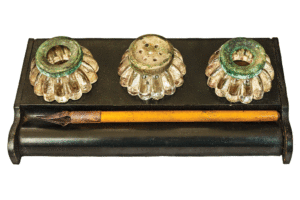
Early inkwells were used for practicality, and fancy inkwells set a status symbol.
The inkwell was a small jar or container made of various materials — such as porcelain, silver, pewter, brass or another metal — which held ink for writers to dip their quills or pens into when scribing a note or letter.
They have a fascinating and practical history in the antique world.
The earliest forms of inkwells date back to the times of Ancient Egypt, where wealthy families hired writers called scribes to write their missives for them.
These early inkwells were stones with round holes that held the ink.
Many elaborate inkwells can be found from European origins from the 16th century forward.
Before this time period, writing was thought to be a demeaning task, and aristocracy left this endeavor to scribes.
However, with the invention of the fanciful inkwell with decorative qualities and rich design, the wealthy class decided the task of writing was suited for good taste, and correspondence became eloquent.
People around the world began to use inkwells more often as time went by, and materials varied as they were produced.
The use of animal horns, silver, gold, bronze, metals, glass and more saw their use in the industry as time ticked on in the writing world.
Early inkwells were used for practicality, and fancy inkwells set a status symbol.
During the Renaissance, decorative items of all sorts were introduced along with the baroque era, and silver, jewels, clothing, and inkwells, among other items, were touched with gilding and excessive ornamentation.
During the American Civil War, the necessity for a portable inkwell came into being.
Battlefield correspondence was essential, and wells with a lid were needed for travel.
The wells were housed in a box, known as a compendium, and it could also hold other writing materials.
This form of traveling inkwell also became popular with writers and artists on the move that needed the ink to be secure and ready to use, thus eliminating the dryness that was caused when ink could not be covered, or the hassle of carrying around a delicate ink bottle would present.
The Victorian era saw many inkwells produced, as writing letters and correspondence was popular in this period.
As rail travel advanced during the Industrial Revolution, the Victorians made inkwells with ceramic, pictorial representations of cities that a tourist could buy when stopping in a certain town.
The traveling inkwell was also used in this era, as traveling became more affordable and manageable.
With the invention of the typewriter and the fountain pen, which contained ink inside of a vessel as one wrote, the demise of the inkwell was certain.
The 20th century saw the demand for the object fail, and is replaced today with the fascination and collection of ornate objects from a past rich in creativity, innovation and communication.
(Editor’s note: DeeDee Wood is the owner of Black Cat Curiosities Art and Antiques in Easton, Md., located at 24B Harrison St.)



